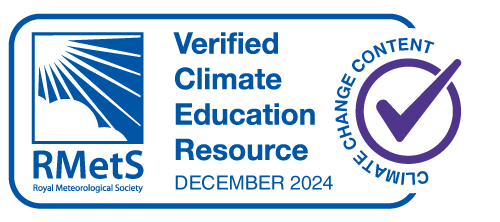Climate Change: Explore I
Why is climate different around the world?
Understanding the climate zones around the world, what causes them, and how they impact on nature and human activity is an important platform for understanding how climate change is already affecting and may affect different places.
This is recommended as session two in the KS3 Climate Change unit of learning, exploring an understanding of different climates.

RMetS quality assurance mark is for the quick starter activity 'agree or disagree'.
Preparation
Green skills
- recording data
- data interpretation
Step by step
Quick starter activity
Agree or disagree?
This weather questions starter activity developed by the Royal Meteorological Society generates discussion to identify learners’ misconceptions about the weather.
Agree or Disagree? | Royal Meteorological Society
Main Activity Suggestions
Suggestion 1 (Outdoor)
National Education Nature Park: Investigate Weather and Microclimates. Use our digital tool to take and record measurements related to the microclimates of your school grounds and compare it to other local areas. This supports learners to reflect and explore why some locations have different temperatures and conditions. Alternatively, learners could use a digital or infrared thermometer to measure and record the temperature of different areas of the school grounds.
Suggestion 2 (Indoor)
Royal Geographical Society: Why is our climate like this? This activity supports learners to explore how climates are a result of latitude, altitude, distance from the ocean, location on the continent and local geographical features, such as topography or nature of the built-up area.
Suggestion 3 (Indoor)
Royal Meteorological Society: UK Climate. In this activity, climate zones are reviewed before exploring regional climate differences across the UK and the reasons for them.
Top Tips
Ensure that an understanding of climate is relevant to learners by drawing on their experiences of different climates around the world.
A reflective question to link this session to climate change can be: ‘What are the impacts of changes to the different climates around the world (and to microclimates in our local surroundings)?’
Curriculum links
- Place: Understanding the physical and human characteristics of real places.
- Space physics: The seasons and the Earth’s tilt, day length at different times of year, in different hemispheres.